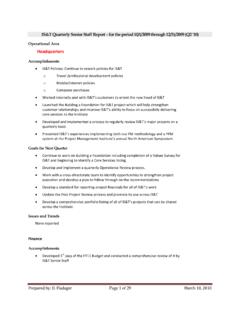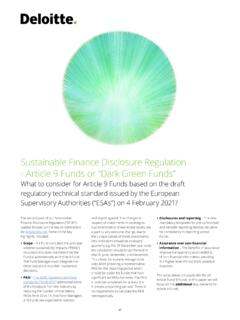Transcription of Sustainable Finance Disclosure Regulation - Article 8 ...
1 01 Sustainable Finance Disclosure Regulation - Article 8 Funds or Light Green Funds What to consider for Article 8 Funds based on the draft regulatory technical standard issued by the European Supervisory Authorities ( ESAs ) on 4 February 2021 On Thursday 4 February 2021, the European Supervisory Authorities ( ESAs ) published the updated draft regulatory technical standards ( draft RTS ), which is intended to supplement the Sustainable Finance Disclosure Regulation ( SFDR ). If approved, these will come into force on 1 January 2022. In the absence of regulatory guidance for firms to comply with SFDR, we produced our first paper on the implications for Article 6 Funds earlier this year. Some of and Fund considers sustainability risk or not and it should be updated on a regular basis. Sustainability risk is integrated into the existing Risk Management Frameworks demonstrating linkages, dependencies and potential impacts to support decision areas above should be applicable for all Funds, unless sustainability is deemed to not be relevant for a specific Fund.
2 Following on from the Article 6 guide, we are now going to focus on the additional requirements for Article 8 Funds. the key highlights from our initial paper were: Fund managers and Funds should document their policy on integrating sustainability. The policy should be documented for each Fund, be reviewed and approved by the board of directors of the Fund manager on an annual basis. The sustainability policy should be included on the website and the website Disclosure should be a separate section which states whether the Fund manager 02 ScopeAn Article 8 Fund under SFDR is defined as a Fund which promotes, among other characteristics, environmental or social characteristics, or a combination of those characteristics, provided that the companies in which the investments are made follow good governance practices.
3 The draft RTS contains some limited guidance and indications as to what constitutes an Article 8 Fund. One way for a Fund to promote environmental and social characteristics and to be an Article 8 Fund is to adopt the mandatory principal adverse sustainability indicators ( PASIs ). In our view if a Fund considers the PASIs, this does not mean they are automatically an Article 8 Fund. The Fund Manager must integrate the sustainability risk indicators into their investment decisions. In the feedback in the draft RTS the ESAs have noted some key unanswered questions whether Funds using exclusion strategies that are not actively promoted are Article 8 Funds, but the ESAs have deferred this to the European Commission and we are still waiting on clarification on this and some other questions. Deloitte s view: Not all funds that adopt the PASIs are automatically considered Article 8 Funds.
4 The risk indicators should be integrated into investment ParibasNNIPAXAR obecoAllianzGISEBB lackRockcredit SuisseHandlebankenCandriamDWSF idelity TrustSchrodersMirovaPictetStorebrandJP MorganBaillie GiffordUnigestionVanguardAviva5505004504 0035030025020015 0100500 Source: 8 Article 9 Morningstar has surveyed a sample of the 30 Fund managers and found that French Managers Amundi and BNP Paribas offer the largest number of Funds classified as Article 8. Other Fund managers have chosen to classify fewer Funds as Article 8 and they are cautious about classifying Funds under SFDR. Deloitte s view: Fund Managers should see SFDR as an opportunity to demonstrate their commitment to Sustainable investing and as investor demand grows, sustainability funds will become a standard look at the fundsNumber of fundsFund Manager03 Principal adverse impact disclosuresThe draft RTS has addressed some of the feedback from the industry by reducing the number of mandatory PASIs that firms are expected to monitor and report against.
5 In addition, the new mandatory templates for pre-contractual and periodic reporting disclosures allow for consistency in reporting across Funds. In the draft RTS the ESAs have reduced the indicators from 32 to: 14 for investments in investee companies (plus one additional environmental indicator (Table 2) and one additional social indicator (Table 3)); 2 for investments in sovereigns and supranationals; and 2 for real estate assets as included in Annex I of the draft sustainability indicatorMetricChange from 23 April 2020 Climate and other environment-related indicatorsGreenhousegas emissionsGHG Carbon emissionsGHG Carbon emissionsScope 3 GHG to be disclosed from 1 January 2023 Carbon footprintCarbon footprintNo changeGHG intensity of investee companiesGHG intensity of investee companiesPreviously weighted average GHG intensity Exposure to companies active in the fossil fuel sectorShare of investments in companies active in the fossil fuel sectorPreviously share of investments in solid fossil fuel sectorsShare of non-renewable energy consumption and productionShare of non-renewable energy consumption and non-renewable energy production of investee companies from non-renewable energy
6 Sources compared to renewable energy sources, expressed as a percentagePreviously total energy consumption from non-renewable sources and shareof non-renewable energy consumptionEnergy consumption intensity per high impact climate sectorEnergy consumption in GWh per million EUR of revenue of investee companies, per high impact climate sectorPreviously Energy consumption intensity per sectorBiodiversityActivities negatively affecting biodiversity sensitive areasShare of investments in investee companies with sites/operations located in or near to biodiversity-sensitive areas where activities of those investee companies negatively affect those areasPreviously share of investments that do not assess, monitor or control the pressurescorresponding to the indirect and direct drivers of biodiversity and ecosystem changeWaterEmissions to waterTonnes of emissions to water generated by investee companies per million EUR invested, expressed as a weighted averageNo changeWasteHazardous waste ratioTonnes of hazardous wastegenerated by investee companies per million EUR invested, expressed as a weighted averageNo changeThe table below illustrates the 14 mandatory indicators from the draft RTS and any changes from the initial draft RTS issued on the 23 April 2020.
7 04 Adverse sustainability indicatorMetricChange from 23 April 2020 Social and employee, respect for human rights, anti-corruptionand anti-bribery mattersSocial andemployeemattersViolations of UN Global Compact principles andOrganisation for EconomicCooperation and Development(OECD) Guidelines for Multinational EnterprisesShare of investments in investee companies that have been involved in violations of the UNGC principles or OECD Guidelines for Multinational Enterprises Previously share of investments in entities without due diligence policies on issues addressed by the fundamental ILO Conventions 1 to 8 Lack of processes and compliance mechanisms tomonitor compliance withUN Global Compact principles and OECD Guidelinesfor Multinational EnterprisesShare of investments in investee companies without policies tomonitor compliance with the UNGC principles or OECD Guidelines for Multinational Enterprises or grievance/complaints handling mechanisms to address violations of the UNGC principles or OECD Guidelines for Multinational EnterprisesUnadjusted gender pay gapAverage
8 Unadjusted gender pay gap of investee companiesPreviously average gender pay gap of investee companiesBoard gender diversityAverage ratio of female to male board members in investee companiesNo changeExposure to controversialweapons (antipersonnel mines,cluster munitions, chemical weapons and biological weapons)Share of investments in investee companies involved in the manufacture or selling of controversial weaponsPreviously only included land mines and cluster bombsIndicators applicable to investments in sovereigns and supranationalsEnvironmentalGHG intensityGHG intensity of investee countriesNewSocialInvestee countries subject to social violationsNumber of investee countries subject to social violations (absolute number and relative number divided by all investee countries), as referred to in international treaties and conventions, United Nationsprinciples and, where applicable, national lawNewIndicators applicable to investments in real estate assetsFossil fuelsExposure to fossilfuels through realestate assetsShare of investments in real estate assets involved in the extraction, storage, transport or manufacture of fossil fuelsNewExposure toenergy-inefficientreal estate assetsShare of investments in energy inefficient real estate assetsPreviously mandatory indicator for all funds and now only real estate05 Some of the changes above were designed to align the metrics to other frameworks.
9 The key highlights are: The updates in respect of investments in sovereigns, supranationals and real estate assets are a particularly welcome change, due to the unique nature of these investments. The PASIs now include violations of UN Global Compact principles and OECD Guidelines for Multinational Enterprises, and lack of processes to monitor adherence to the same. For climate related PASIs, the metrics have now been aligned in part to the indicators used for EU Climate Transition or Paris-aligned Benchmarks under the Low Carbon Benchmark Regulation (EU 2019/2089). For Fund of Funds, firms should do a look through to the end investment, holding company or special purpose vehicle (SPV) in order to assess the PASIs. For green bond investments financing a specific project the PASIs should be assessed for the specific project rather than the entire business of the issuer.
10 PASIs should be assessed quarterly March, June, September and December. This allows for a yearly average to be calculated providing a representative PASIs for the reporting period which should be easier for Funds that have portfolio turnover. The PASIs should be completed for at least the five previous reporting s view: The reduced mandatory indicators is a welcome decision for the Irish funds industry and the alignment of some of the indicators to existing frameworks shows harmonisation by the European Commission. In addition there are still complexities with accessing the data from investee companies and this will be only be enhanced with the recent announcement on the proposed Corporate Sustainability Reporting Directive ( CSRD ) by the European Commission on the 21 April 2021. This will bring more companies in scope and the CSRD will align with the SFDR and the Taxonomy.

















